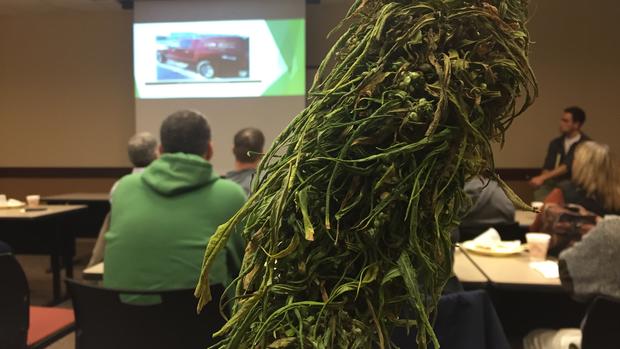WILLMAR— With the potential for high per-acre profits there’s increasing interest in growing industrial hemp on west central Minnesota farms.
But with limited processing options available, an untested market chain and federal law that still classifies industrial hemp as a controlled substance, there are a few roadblocks yet to overcome.
That’s why a feasibility study that could detail the financial risks and gains of growing, processing and marketing industrial hemp is expected to be undertaken by the Kandiyohi County Ag and Renewable Energy Committee.
The committee, which is part of the Kandiyohi County and City of Willmar Economic Development Commission, hosted an informational meeting last week in Spicer with individuals involved with growing, researching and licensing hemp in the state.
With a full house of people eager to learn about industrial hemp, the speakers discussed the potential profits and the possible pitfalls of the crop.
The emphasis was clearly on the positive possibilities for industrial hemp in the U.S.
With 50,000 different uses for hemp as food, fiber and a dietary supplement, there are options for a “candy store of innovation,” said Harold Stanislawski, who is in charge of Minnesota’s industrial hemp initiative with the Agricultural Utilization Research Initiative.
“This crop has so much innovative ability to create economic development,” he said. “You’re on the right track.”
In 2014 the federal government allowed states, including Minnesota, to launch regulated pilot projects for industrial hemp.
Industrial hemp is oftentimes associated with marijuana, but they are very different plants and the level of chemicals in hemp that give a “high” are extremely low. However, because there are trace amounts, states like Minnesota must test locally-grown hemp as part of the licensing process.
There were about 100,000 acres of industrial hemp planted in 2018 across the country, said Margaret Wiatrowski, the industrial hemp program coordinator for the Minnesota Department of Agriculture.
In Minnesota there were about 45 licensed growers who planted 700 acres this year. Most were small plots of five to 10 acres, Wiatrowski said.
There are currently 10 processors licensed in the state, including Charles Levine, who grows and processes an industrial hemp food-grade protein and oil at his Waconia business, Hemp Acres, LLC.
Levine estimated the current industrial hemp food market at nearly $800 million in the US.
He said the hemp industry will continue grow, especially if Congress takes action when approving the new farm bill to remove industrial hemp from the list of controlled substances.
That action would make growing and processing industrial hemp legal in all states, but it would still require states to regulate it.
Selling industrial hemp products as food and fiber products is already legal, but the legal aspects of selling cannabidiol (CBD) oils that are used as dietary supplements or pharmaceuticals is technically not legal but is not heavily enforced.
Growing hemp for CBD is more labor intensive than growing it for food or fiber but it’s also the most financially lucrative with the potential to generate more than $2,500 per acre in profits, Levine said.
Wiatrowski said interest in growing hemp for CBD has resulted in a high number of applications for the 2019 season, with nearly 90 percent of growers indicating they intend to plant the type of hemp needed for the medicinal oils.
“They just see the dollar signs there,” she said, adding that it’s also the most “difficult and complicated” part of the hemp industry.
Some states are ahead of Minnesota in terms of processing and marketing different hemp products.
The research currently underway at the AURI labs in Marshall is designed to provide solid information about markets before farmers start producing large amounts of industrial hemp.
“We’re trying to connect the dots here in Minnesota … so if you raised this crop you have a market for it,” Stanislawski said. “There’s a lot to learn in this business yet,” he said.
AURI’s report is expected to be completed in February.
Stanislawski said it may be prudent to team up with neighboring states to study options for processing industrial hemp, including the machinery needed to turn sturdy hemp stalks into fibers for industrial uses.
Levine said other countries jumped on the industrial hemp market decades ago and the United States needs to catch up.
He said the US is “about 20 years behind the boat” compared to Canada and about “40 years behind” European countries.
West Central Tribune by Carolyn Lange

